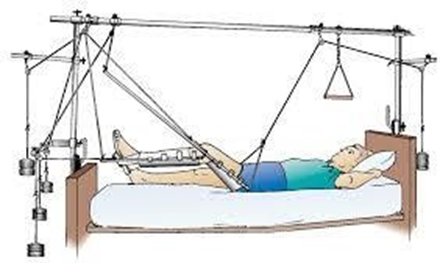A client with a fracture of the right femur has had skeletal traction applied. Which intervention should the nurse include in the client's nursing care plan?
Assess the pin sites for signs of infection.
Administer pain medication at designated intervals around the clock.
Assess the pulses proximal to the fracture site.
Remove traction every shift and provide skin care.
The Correct Answer is A
A. Assessing the pin sites for signs of infection is essential in clients with skeletal traction to detect any early signs of infection, such as redness, swelling, warmth, or purulent drainage. Prompt identification and management of pin site infections can prevent complications.

B. Administering pain medication at designated intervals around the clock helps to ensure adequate pain control and comfort for the client. However, this intervention alone does not specifically address the care needs related to skeletal traction.
C. Assessing the pulses proximal to the fracture site is important for monitoring circulation and detecting any signs of impaired perfusion. However, this assessment is not directly related to the care of skeletal traction itself.
D. Removing traction every shift is not indicated unless there is a specific reason to do so as ordered by the healthcare provider. Continuous traction is often necessary for proper alignment and stabilization of the fracture. Additionally, providing skin care is important to prevent skin breakdown around the traction device, but removing traction every shift is not part of routine care.
Nursing Test Bank
Naxlex Comprehensive Predictor Exams
Related Questions
Correct Answer is D
Explanation
A. Auscultating the abdomen for bowel sound activity is important, but the priority is addressing the dehisced and eviscerated wound.
B. Bringing additional sterile dressing supplies is a good idea, but the priority is addressing the dehisced and eviscerated wound.
C. Obtaining a sample of the drainage for laboratory analysis can wait until the client's immediate needs are addressed.
D. Preparing the client to return to the operating room is the priority to address the dehisced and eviscerated wound and prevent further complications.
Correct Answer is A
Explanation
A. Restricting protein intake is often recommended for clients with glomerulonephritis to reduce the workload on the kidneys and decrease proteinuria. This can help slow the progression of kidney damage.
B. Increasing intake of high-fiber foods may be beneficial for overall health but is not specifically indicated for glomerulonephritis management.
C. Limiting oral fluid intake to 500 mL/day is not appropriate for most clients and may lead to dehydration, which can exacerbate kidney dysfunction.
D. Increasing intake of potassium-rich foods may be contraindicated in some cases of glomerulonephritis, especially if the client has hyperkalemia. Dietary potassium restriction may be necessary depending on the client's lab values and kidney function.
Whether you are a student looking to ace your exams or a practicing nurse seeking to enhance your expertise , our nursing education contents will empower you with the confidence and competence to make a difference in the lives of patients and become a respected leader in the healthcare field.
Visit Naxlex, invest in your future and unlock endless possibilities with our unparalleled nursing education contents today
Report Wrong Answer on the Current Question
Do you disagree with the answer? If yes, what is your expected answer? Explain.
Kindly be descriptive with the issue you are facing.
